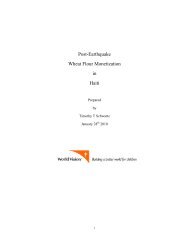Food Consumption Patterns Part 2
Create successful ePaper yourself
Turn your PDF publications into a flip-book with our unique Google optimized e-Paper software.
76<br />
How good for the health are the products is hard to say without some investigation. Bongu’s labels<br />
do not list how much of each ingredient is in a product. Nor do the labels make clear that substitute<br />
ingredients have been added. However, we know that international law requires that ingredients<br />
be at least listed by the order of quantity, thus the most abundant ingredient first, second most<br />
abundant next, and so on. If Bongu has followed the international law then the primary ingredient<br />
in its condensed milk—list first--is “skim milk.” Then comes “soy milk”, then “maltadextrine”--a<br />
sweetless sugar used as a thickening agent--then “vegetable fatty matter” and finally “soy lecithin.”<br />
The other ingredients are an unknown measure of vitamin A and D and chemical preservatives. In<br />
comparison, the main and only food ingredient in the Carnation milk competitor—the one knocked<br />
off the market by Bongu--is milk (Figure 24). Bongu cheese lists palm oil as its primary ingredient.<br />
Then it lists three milk products: milk proteins, powdered milk, and whey. No cheese. In<br />
comparison, the main ingredients in the processed cheese La Vache Qui Rit—also almost<br />
completely knocked out of the popular market by Bongu--are “cheddar, Swiss, and semisoft<br />
cheese” (Figure 25)<br />
Figure 33: Bongu Milk Content Comparison to Carnation<br />
Carnation Milk<br />
Nutritional<br />
information<br />
vs<br />
Bongu Milk<br />
Nutritional<br />
information?<br />
Figure 34: Bongu Cheese Content Comparison to La Vache Qui Rit<br />
vs<br />
Ingredients: 50% Cheese<br />
Ingredients: 0% Cheese
















